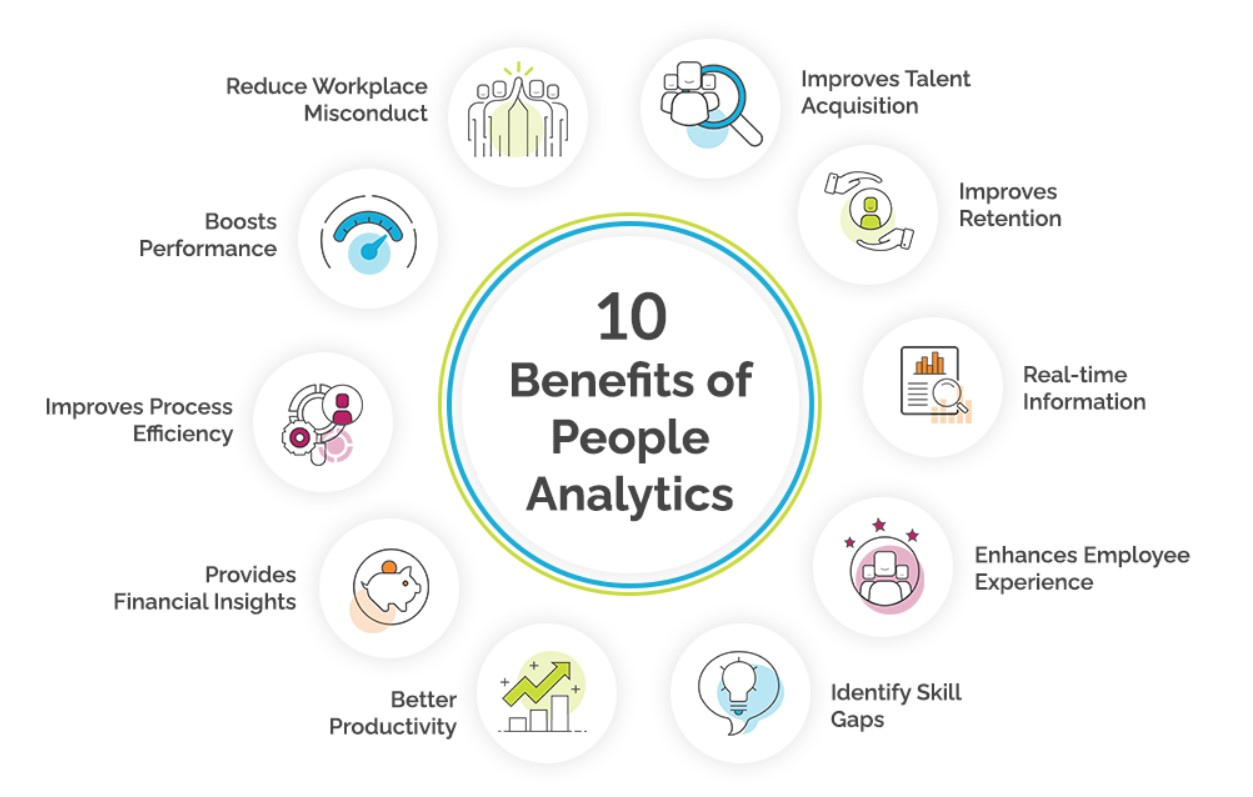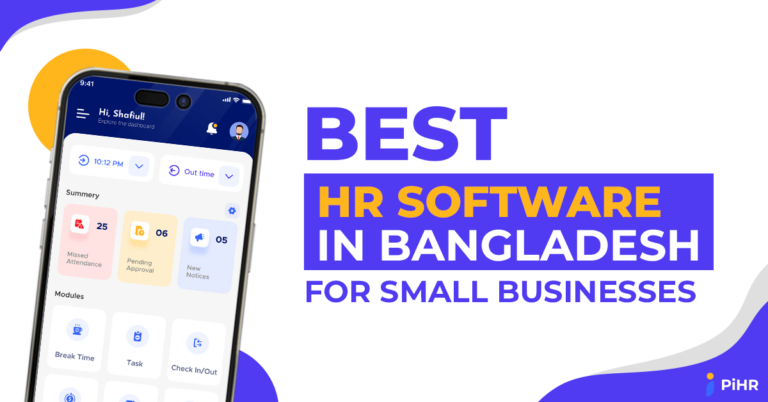In this 21st century, human resource is one of the most significant aspects in a company’s road to success. If you ask 10 entrepreneurs about the biggest challenge in forming a business, almost all of them would likely indicate one thing – cost management. But in reality, HRM, the people part, is the most challenging part in a business.
People form the most integral part of maintaining constant growth and retaining sustainability in a company. From an HR standpoint, maintaining such a crucial part of a company presents both challenges and opportunities.
And so, to better understand some of the current human resource challenges in Bangladesh, we’ve put together a list that’ll help you to get ahead of the HR problems and think about how to solve HR issues.
Top 20 Common HR Challenges and Issues in Bangladesh With Solutions
The biggest challenge of maintaining a global presence is to understand the HR needs in a certain region where the workforce is located. All these could be bundled with cultural differences and language barriers, which makes the current human resource issues even more challenging.
Regardless, the core principles of HR still apply to most companies around the world while addressing the following HR issues:
01. Emphasizing On Employee’s Mental Health and Overall Wellbeing
Coming out of the COVID-19 lockdown, the importance of employee wellbeing cannot simply be understated. In fact, one pandemic has taught every company in the world to emphasize employee wellbeing and mental health to keep their productivity and motivation at an optimal level.
It is safe to say that all the buzz around mental state health conditions is not to be taken lightly by any HR leaders. It is why companies are investing large sums of money to ensure the employees’ health is ensured and so they remain confident in facing new challenges and opportunities.
Issues
- Lack of productivity and motivation among employees, leading to inefficient output.
- Potential burnout, which results in suboptimal results.
- Mental health problems of employees affect overall company performance.
Solutions
- Emphasis on wellness culture should be from the top, making it a vital part of the company’s overall work culture.
- Make stress management a priority, and teach employees practical skills to better manage their deadlines and workload.
- Make regular mental health awareness toolkits and campaigns so that leaders and members alike are always cognizant of their mental health.
02. Creating A Sense Of Accountability As A Core Part The WorkPlace Environment
The first step toward creating a productive workforce is to create a self-accountable culture inside the workspace. This action ties everyone working in a workplace into being accountable for their actions, decisions, and results. Having a repercussion for these decisions help the employees to take the effective decision, thus creating a self-driven productive workforce.
Issues
- Lack of effective action among leaders leads to incomplete or suboptimal projects.
- Eroded trust in managers, leaders, and colleagues, which results in dysfunctional dynamics within the company.
- Declining engagement among employees results in a lack of productivity and a loss of efficient output.
Solutions
- Create two-way feedback mechanisms to ensure all team members, project managers, and leaders are holding each other accountable for their actions.
- Facilitate transparency and evaluation so that everyone in the company is fairly evaluated and rewarded accordingly for their contribution.
03. Adapting to A Hybrid Work Model
Adapting to a hybrid work model is still a massive challenge for every company around the world. Even more, this change was forced due to the COVID-19 situation. Yet, such adaptations in the work environment have shown positive results according to studies conducted by Nasscom and Indeed.
Almost 70% of the companies are trying to adapt to a hybrid work environment after discovering that it increases employee satisfaction by 66%. This is to say that testing and implementing a successful hybrid work model is a significant challenge for every HRM.
Issues
- Lack of employee satisfaction stemming from an inflexible schedule leads to lapses in productivity and an apathetic attitude towards work.
- Declining flexibility and productivity means that those employees will not be putting all their effort into their work, marking a huge loss for the company.
- Resistance to change is a huge problem for employees who are used to the offline model of work and are unwilling to switch to a hybrid environment.
Solutions
- The development of virtual learning environments will allow employees to meet deadlines and complete their tasks online.
- Implement clear policies for hybrid arrangements so that no one is working overtime, and everyone can maintain a clear, balanced schedule.
- Make incremental changes so that there isn’t a sudden whiplash for employees who are resistant to change.
04. Securing The Talent Recruitment War
One of the most prominent problems of every HR group is to continuously draw the best talent from the global talent pool. Besides, in order to employ the right talent for your organization, not only do you have to sell him/her the job, but also the work location.
Add remote recruitment, interviewing, and signing to the list and it compounds the challenge of hiring the right talent. This is to say that there is no golden framework for hiring talent. And with global presence, it becomes increasingly difficult to employ and allocate the right resources in the right places.
Issues
- Securing the right, qualified person for the job is a tall order, especially when so much of the hiring process is done manually.
- Data-driven recruitment can be inaccurate due to the collection and manual processing of data.
- Recruiting efficiently is difficult due to evaluation and communication all being manual.
Solutions
- Diversify recruitment strategies by coopting social media, posting on career sites, going to job fairs, etc.
- Automate the hiring process by using software wherever possible to reduce the manual workload.
- Train hiring teams so that they can secure the best person for the job
05. Creating A High Performing Workforce
Creating and maintaining a high-performing workforce is a challenge even for the most efficient HRM in an organization. Working on and offsite has made it even more challenging for HR leaders to maintain a balanced output as seen during the COVID-19.
To focus more on the point, there is no proven methodology or framework that can be used to boost the productivity of the employees working onsite and offsite. This makes it confusing for the HR leaders to take the most efficient decision to motivate their employees and keep their productivity rate at an optimum level.
Issues
- Low productivity can occur if employees are pushed to their breaking point while trying to create a high-performing team.
- No specific proven methodology or framework to complete specific tasks will lead to employees being uncertain about company goals.
- A high rate of demotivation can arise due to a highly competitive work environment.
Solutions
- Promote a healthy work-life balance for everyone in the company so that overall morale remains high.
- Employ integration and socialization activities so that everyone gets to know each other better, and there is high engagement among team members.
- Provide feedback, and recognition and implement a reward system so that employees are incentivized to work harder and meet their targets.
06. Using Automation to Perform The Routine Tasks

While HR is highly involved in making the entire workforce efficient and productive, it’s important that the team becomes efficient itself. Using AI tools and automation techniques, 56% of all HRM tasks can be automated according to research led by McKinsey Global Institute.
Even though automation allows a lot of time to train and educate the employees, there are still a lot of caveats to this process. Such as – tasks like critical problem solving, teamwork, listening, communication, and understanding – all these are impossible to replicate and automate using AI tools.
Issues
- Sometimes there are complexities with integration, the software may not work with the existing operating systems of the company.
- Employee resistance to automation stems from employees not wanting the work environment to change.
- Some tasks cannot be automated.
Solutions
- Using the right accounting software will eliminate most of these issues.
- Providing training for employees will help ease them into the new automated system.
- Optimizing tasks that cannot be automated is the best solution to ensure no one is doing mundane tasks, which will result in a lack of motivation.
07. Being Acquainted with Knowledge of People Analytics

Being able to make informed decisions is one of the best ways to create an accountable working environment. Using a data-driven decision-making policy backed by People Analytics, HR can create a decision-making system based on pure information.
Up and until now, corporations have relied on experience, intuition, team collaboration, and mutual understanding in making important decisions. However, with the inclusion of people analytics, the HR teams feel confident about taking effective decisions. However, it leaves the challenge of training the HR teams in analytics, strategy formulation, and generating outcomes.
Issues
- Lack of training of HR in analytics results in inefficient people analytics.
- Gaining meaningful insights using data analytics can sometimes be difficult, because of the uncertainty of that data.
- Uncertainty with data management results in untrustworthy data generation.
Solutions
- Using the correct visualization tools and database technologies will make people analytics a breeze for everyone involved.
- Training HR personnel will ensure that the data is not breached, is trustworthy, and there is no uncertainty in the data.
08. Authorizing The Use of A Universal Cloud-based HR Application

In 2024, every HR employee must know the use of HR and payroll software for employee management. This can be done efficiently using a unified platform rather than using a number of apps dispersedly.
Even more, this allows for efficient communication between different teams and their employees, thus reducing the communication gap and loss of valuable information.
Issues
- Performance Challenges occur when the software isn’t properly integrated with the rest of the system.
- There can be security concerns with the software.
- Many workers display a lack of knowledge when it comes to operating cloud-based software.
Solutions
- Implement robust security measures so that there are no chances of data breaches occurring.
- Train personnel in using the software.
- Maintain detailed documentation for integration for seamless integration.
09. Discussing Ideas on Positive Change and Compatibility
Not all people in a workplace are susceptible to frequent change as reported by Gartner in their 2023 goals. Their study shows that minute adjustments in daily workflow create more than 2.5 times more anxiety-related stress than large and infrequent changes.
This is to say, such changes can put a lapse in the employees’ productivity, and concentration, and might disrupt the overall workflow to a certain extent, thus unsetting them.
It is the job of HR to build trust in its employees and to ensure that minor changes do not necessarily affect their productivity bubble inside the workplace.
Issues
- Productivity Lapses can occur if workers need to get used to these minute positive changes.
- Changes to the workflow can completely disrupt workflow for employees who aren’t used to it.
- Studies have shown that workers face high levels of stress when small changes are made to their work.
Solutions
- HRM should develop a comprehensive framework for change implementation.
- Make incremental changes to ensure that employees have time to get accustomed to the little changes.
10. Achieving A Measurable DEI Progress
This is a common underlying issue in any workplace as for most HRM, DEI is a strategic objective. Most often than not, organizations tend to put marked DEI indicators on a low priority list in favor of other business objectives. This is why many HRMs face the problem of holding their company accountable for not providing the actual DEI results.
Issues
- Employees are often resistant to change and are hesitant to co-opt DEI initiatives.
- There are limited data and metrics that can properly measure DEI.
Solutions
- Appoint dedicated DEI leaders who can facilitate these initiatives easily.
- Prioritize DEI as part of the company’s strategy so that workers slowly get accustomed to it.
11. Legal and Compliance Challenges
Maintaining HR compliance is one of the main tasks of a company. You must ensure that your employers are not facing legal and ethical issues at work. You need to make sure your employees are not facing harassment, not just at the workplace but also during hiring, discrimination, or other ethical concerns at the workplace. The legal team needs to be well-equipped to deal with situations if they arise and to make sure people are held accountable for their actions. Not to mention, there are other legal concerns regarding safety issues, risk management, and understanding medical coverage requirements.
Issues
- Security issues can arise from the different software being used, lack of passwords, a highly collaborative work environment, and even lack of privacy due to digital surveillance.
- Risk management is an important thing to note because the safety of workers is the most important thing in a company.
- Avoiding discrimination is important, not just at the workplace, but also during hiring practices to make sure the hiring process is fair and just.
Solutions
- You should employ secure Accounting Software where all the data is encrypted and password protected.
- There should be clear policies regarding legal and compliance issues.
- A company should always train personnel in risk management and fair hiring policies.
12. Employee Retention
While it is essential to hire properly the workers who have already been hired are equally important. The employees that you retain play a crucial role in boosting the company. There are several key factors where employee retention plays a positive factor. A good employee retention ratio results in increased productivity, greater customer satisfaction, improved company culture, reduced training costs, and greater revenue.
Retained employees don’t need retraining usually, they have more experience working with the company and know how to navigate rules within the company well. Not to mention, having a large part of the workforce who are experts helps improve the company culture.
Issues
- Hiring the wrong candidate can result from inefficient or manual hiring practices.
- Lack of employee rewards and recognition means that employees often get demotivated.
Solutions
- Making employee rewards an established part of the work culture will keep workers highly engaged.
- Better hiring practices will ensure the right person is hired for the right role.
- Making health and wellness in the workplace a priority will make all workers feel motivated and less stressed.
13. Performance Management Challenges
Performance management is an important tool that can help managers monitor their employees’ performance. It can also help to evaluate their work. The goal of performance management is to ensure that the work environment is positive, and reinforcers their productivity. This is important to foster an environment where people want to perform to the best of their abilities and can stay in line with the company’s goals.
Performance management boosts employee performance, increases employee retention, recognizes employee productivity, and helps in defining career paths for employees.
Issues
- The lack of clear strategies makes workers demotivated.
- Poor performance and siloed working can occur if a team insulates itself from the rest of the company and has poor communication.
- Ineffective goal setting results from ineffective leadership.
Solutions
- Make sure team leaders and project managers have defined and measurable goals and outcomes.
- Monitor performance effectively to ensure all workers are engaged and highly motivated.
- Establish a feedback loop to hold everyone accountable.
- Use collaborative tools to foster better communication and collaboration within the company.
14. Training and Development
One of the key factors in ensuring business success is training new and existing workers. Better training results in more productivity among workers. It also reduces turnover and increases engagement. It makes sure that employees are retained, and improves employee satisfaction. This consistency allows employees to improve their performances and give back to the company.
This also results in creating future leaders for the company, and results in better personal growth for the company. All of this training and development ensures that employees feel more confident
However, many challenges come with training workers. It can be costly, and there may be information overload, which leads to disengaged employees.
Issues
- Information Overload can result in employees disengaging from training overall.
- Disengaged employees will not participate in training modules or respond to training well.
- Many companies provide Irrelevant or outdated training to their employees because they haven’t updated their training modules.
Solutions
- Create a well-paced training schedule with frequent checkpoints to ensure everyone is engaged.
- Establish a feedback loop with the workforce so that trainers also have accountability.
- Conduct research before implementing a training module to make sure the module isn’t outdated or irrelevant.
15. Managing organizational change effectively
No company will stay stagnant forever. There is constant change within a company, and most workers are hesitant to adapt to that change. Multiple challenges come with managing organizational change effectively.
If projects are well planned and can keep up with the changing pace of the company, it increases the likelihood of project success. Companies can better achieve their outcomes, meet their expected returns on investment (ROI), and generally avoid failures that could cost a lot.
There are some difficulties in managing change. Often there is a lack of engagement, or maybe some employees are resistant to the idea of change. However, change is necessary to ensure that the company achieves all its outcomes.
Issues
- Sometimes there is a severe lack of engagement from employees.
- Since change is uncomfortable for most people, many employees display resistance to change.
- Lack of measurable outcomes leads to team members feeling demotivated.
Solutions
- Set clear strategies and frameworks for measuring outcomes so that employees have a quantitative way of measuring output.
- Make incremental changes to give everyone enough time to adjust.
- Promote a healthy workplace environment to keep employees engaged and motivated.
16. Communication and Collaboration
Fostering effective communication and a collaborative workplace is the ultimate goal for all companies. It’s crucial to build connections not just within the team, but also between teams of the company so that everyone can work in synergy.
To achieve a common goal that is beneficial for the company, it’s essential to have seamless streams of communication between all parties. Having more effective communication and collaboration leads to improvement within the team. It makes the team function efficiently and makes problem-solving much easier. This leads to the long-term success of the company.
Issues
- Miscommunication often occurs when members of the team are not collaborating properly.
- There is poor engagement between employees.
- Many companies lack collaborative infrastructure
Solutions
- Effective leadership and project management will help solve most of these issues.
- All teams should make use of collaborative tools.
- Leaders should ensure a constant feedback loop with team members to update them.
17. Globalization and Cross-Cultural Challenges
The increasing trend of hybrid work models means that companies often hire international workers. While globalization is certainly a net positive, some cross-cultural challenges must be addressed.
As we head into a post-COVID-19 world, we must deal with the reality of remote work being the norm. Given that’s true, most companies are looking to expand their workforce beyond their geographical borders. While this is great for the expansion of the company, and to get experts internationally, it also comes with its own set of challenges.
Having different team members in different time zones can be a difficult thing to navigate. Not to mention, having people in different countries, and sometimes even continents, brings forward cultural barriers.
Issues
- Language and time-zone barriers may exist between domestic and international members.
- Different leadership styles can cause issues when there are people from different nationalities in the same team.
- Communication between members may be faulty due to cross-cultural barriers.
Solutions
- Training team leaders effectively is imperative to ensure that all members of the team feel comfortable.
- Everyone should be given sensitivity training so that different cultures are acknowledged and respected.
- Project managers should go through comprehensive planning to accommodate time-zone differences
18. Building a winning culture
Establishing a winning culture is the recipe for success. If you’re looking for speed, efficiency, and high-impact results within your company, building a winning culture is the most important goal to achieve.
Having a winning culture is important in ensuring employee loyalty. When you have a winning culture, your employees are inspired to work harder, to be more productive, and to bring measurable successes to the company.
A winning culture equates to having a high-functioning, highly efficient team, which results in fewer internal conflicts, more unity, and an effective company culture.
Issues
- Sometimes employees can get derailed by workload.
- There can be a need for measurable outputs, leading to uncertain goals.
Solutions
- Appoint appropriate leaders and managers to convey clear, measurable goals to the team.
- Fostering effective communication between teams is crucial to maximizing engagement.
- Fostering a healthy environment with a healthy work-life balance is one of the most important things to maintain in a highly productive work environment.
19. Work-Life Balance
The most important thing in today’s day and age is to have a healthy work-life balance. Without that, people’s mental health gets exponentially worse. This not only leads to a decline in the quality of their personal relationships but also their productivity at work.
With the current focus on hustle culture and productivity, employees often forget to take care of themselves, and that ultimately results in low productivity and burnout. Having a good work-life balance leads to better productivity, more engagement, improved mental and physical health, and fever burnout.
If you are a company that positively reinforces having a healthy relationship with work, then you are also likely to retain more employees. This also results in fewer burnouts and an overall increase in employee trust within the company.
Issues
- Low productivity and burnout can occur due to overworking.
- Lack of motivation stems from having a high workload.
- High stress levels lead to depression and other mental health issues.
Solutions
- Prioritizing health and well-being at work such as organizing wellness events should be made the norm.
- It’s of utmost importance to train team leaders and project managers to be flexible and not overwork their employees.
- The company should always provide flexible work opportunities.
20. Leadership Development
Even if you have solved all the other problems stated above, if you miss this one as HRM, then there are going to be even bigger challenges ahead. There are many companies and leaders alike who believe that leaders don’t require further training or development. Many presume this because leaders have supposedly reached a stage where no further development is required.
This is categorically untrue. Leaders also require training to keep up with the ever-changing global work culture. They need training to keep up with new company strategies, to best teach their teams. Additionally, a lack of training and development in leadership leads to inner company conflict and dissatisfaction among employees.
Issues
- There can be some resistance from leaders when they are asked to go through training or development.
- Inner company conflict often arises as a result of mismanagement or lack of development of leaders.
- Any negative interactions with leaders lead to low morale among employees.
Solutions
- Create separate training modules for team managers and leaders
- Make incremental changes within the work culture to normalize such training programs
- Foster good and effective communication within the workplace to decrease conflicts.
Importance of addressing HRM issues and challenges in Bangladesh
Solving HRM issues remains one of the most important aspects of HR. HRM serves as the backbone of a company and is often the sole deciding factor behind the success or failure of a company.
If you want to ensure that trust in the company is retained, and your employees are productive and motivated, you cannot overlook HRM issues and challenges. If not handled properly, you can potentially stifle innovation, hinder company growth, and cause a huge dip in productivity.
As HRM strategies get more diverse and work norms change, as remote work becomes more normalized, new issues will keep propping up and will need to be tackled head-on
It’s crucial to address HRM issues and challenges to understand the potential pitfalls within the company, and how to tackle those pitfalls preemptively. To create a positive work environment, improve hiring practices and retain employees, garner employee trust, and boost overall productivity, it’s of utmost importance to address the aforementioned HRM issues and challenges.
Endnotes
Even though the current human resource issues put the HR of an organization under many challenges to make efficient use of its human force, there are still viable solutions to tackle them in very specific ways.
And, no matter how diplomatically we approach solving these problems, the pandemic has completely changed the plot of this whole situation. This forced HR around the world to rethink new approaches to solving the top human resources issues.
Nevertheless, each change is a new way to rethink, improve our solutions, and develop an effective HRM strategy for the future.












